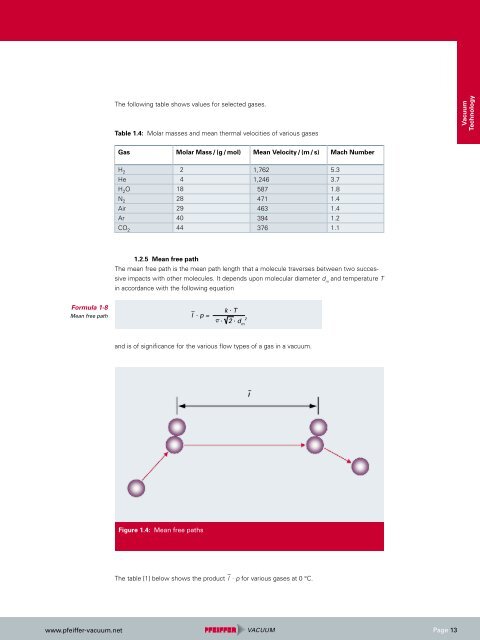- Page 1 and 2: Vacuum Vacuum Technology Technology
- Page 3 and 4: Vacuum www.pfeiffer-vacuum.net Tech
- Page 5 and 6: www.pfeiffer-vacuum.net Vacuum Tech
- Page 7 and 8: www.pfeiffer-vacuum.net Vacuum Tech
- Page 9 and 10: Formula 1-3 Definition of pressure
- Page 11: Pa bar mbar μbar Torr micron atm a
- Page 15 and 16: Formula 1-9 Knudsen number Formula
- Page 17 and 18: Pa m 3 / s mbar l / s Torr l / s at
- Page 19 and 20: Formula 1-17 Blocking Formula 1-18
- Page 21 and 22: Formula 1-23 Molecular pipe conduct
- Page 23 and 24: www.pfeiffer-vacuum.net Solid Liqui
- Page 25 and 26: www.pfeiffer-vacuum.net 1.3.4 Bake-
- Page 27 and 28: Formula 2-1 Compression ratio www.p
- Page 29 and 30: Formula 2-7 Water vapor capacity ww
- Page 31 and 32: www.pfeiffer-vacuum.net Filters Wit
- Page 33 and 34: Model Penta 10 Penta 20 Penta 35 Mo
- Page 35 and 36: www.pfeiffer-vacuum.net The ultimat
- Page 37 and 38: www.pfeiffer-vacuum.net Inlet Appli
- Page 39 and 40: Model MVP 006-4 MVP 015-2 MVP 015-4
- Page 41 and 42: Model XtraDry 150-2 XtraDry 250-1 w
- Page 43 and 44: www.pfeiffer-vacuum.net This result
- Page 45 and 46: Model Hepta 100 Hepta 200 Hepta 300
- Page 47 and 48: www.pfeiffer-vacuum.net 2.6.1 Desig
- Page 49 and 50: Compression ratio K 0 10 2 30 10 1
- Page 51 and 52: www.pfeiffer-vacuum.net Due to thei
- Page 53 and 54: www.pfeiffer-vacuum.net 2.6.4.1 Sta
- Page 55 and 56: www.pfeiffer-vacuum.net Soundproofi
- Page 57 and 58: Model OnTool Booster 150 www.pfeif
- Page 59 and 60: Formula 2-9 Turbopump K 0 Formula 2
- Page 61 and 62: www.pfeiffer-vacuum.net 2.8.1.2 Hol
- Page 63 and 64:
www.pfeiffer-vacuum.net 2.8.1.3 Tur
- Page 65 and 66:
www.pfeiffer-vacuum.net Analytical
- Page 67 and 68:
Characteristic Pure turbo stages Tu
- Page 69 and 70:
www.pfeiffer-vacuum.net The magneti
- Page 71 and 72:
www.pfeiffer-vacuum.net With the ai
- Page 73 and 74:
www.pfeiffer-vacuum.net Figure 3.1:
- Page 75 and 76:
www.pfeiffer-vacuum.net A Pirani va
- Page 77 and 78:
www.pfeiffer-vacuum.net When instal
- Page 79 and 80:
www.pfeiffer-vacuum.net Pirani ther
- Page 81 and 82:
www.pfeiffer-vacuum.net Table 3.2:
- Page 83 and 84:
www.pfeiffer-vacuum.net DigiLine se
- Page 85 and 86:
www.pfeiffer-vacuum.net The followi
- Page 87 and 88:
www.pfeiffer-vacuum.net Inlet Syste
- Page 89 and 90:
Formula 4-2 Stability parameter a F
- Page 91 and 92:
Formula 4-7 Shot orifice Formula 4-
- Page 93 and 94:
www.pfeiffer-vacuum.net The higher
- Page 95 and 96:
Material Y 2O 3 / lr W Re Relative
- Page 97 and 98:
www.pfeiffer-vacuum.net A lattice i
- Page 99 and 100:
www.pfeiffer-vacuum.net Some of the
- Page 101 and 102:
www.pfeiffer-vacuum.net 4.1.2.3 Det
- Page 103 and 104:
Detectors www.pfeiffer-vacuum.net T
- Page 105 and 106:
Inlet System No pressure reduction
- Page 107 and 108:
www.pfeiffer-vacuum.net In the pres
- Page 109 and 110:
www.pfeiffer-vacuum.net The potenti
- Page 111 and 112:
www.pfeiffer-vacuum.net Mass discri
- Page 113 and 114:
5 www.pfeiffer-vacuum.net Leak dete
- Page 115 and 116:
www.pfeiffer-vacuum.net Test gas V
- Page 117 and 118:
Formula 5-1 Leakage rate conversion
- Page 119 and 120:
Suitable With test chamber External
- Page 121 and 122:
www.pfeiffer-vacuum.net Bypass Opti
- Page 123 and 124:
Thickness � 1.00 1.20 1.50 1.60 1
- Page 125 and 126:
www.pfeiffer-vacuum.net Trapezoid s
- Page 127 and 128:
www.pfeiffer-vacuum.net 6.3 Detacha
- Page 129 and 130:
www.pfeiffer-vacuum.net Figure 6.7:
- Page 131 and 132:
www.pfeiffer-vacuum.net 6.5 Valves
- Page 133 and 134:
www.pfeiffer-vacuum.net In principl
- Page 135 and 136:
www.pfeiffer-vacuum.net Venting val
- Page 137 and 138:
www.pfeiffer-vacuum.net Figure 6.15
- Page 139 and 140:
Formula 7-2 K o of a Roots vacuum p
- Page 141 and 142:
p a / mbar 1,000.0000 800.0000 600.
- Page 143 and 144:
Formula 7-9 Calculation of the cond
- Page 145 and 146:
www.pfeiffer-vacuum.net The Roots p
- Page 147 and 148:
Formula 7-10 Diffusion coefficient
- Page 149 and 150:
www.pfeiffer-vacuum.net The turbopu
- Page 151 and 152:
www.pfeiffer-vacuum.net Since p 2 =
- Page 153 and 154:
www.pfeiffer-vacuum.net Vacuum Tech
- Page 155 and 156:
www.pfeiffer-vacuum.net Vacuum Tech
- Page 157 and 158:
www.pfeiffer-vacuum.net Vacuum Tech
- Page 159 and 160:
www.pfeiffer-vacuum.net Acknowledge

















